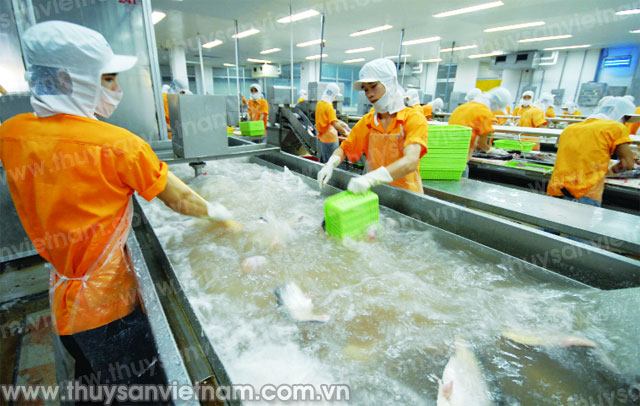Vietnam’s Tra fish was once a “gold” product that brought considerable profits to the Mekong Delta; but now it is facing difficulties without exit in sight. In 2014, can enterprises take advantage of the opportunity to break out?
Fewer opportunities, more thorns
Currently, Vietnam’s Tra fish are exported to 149 countries and territories in which the EU and the U.S. remain the two largest markets, accounting for nearly half of exports. In 2011, the output was over 1.19 million tons with an export value of 1.8 billion USD. In 2013, exports slightly increased compared to 2012 and reached 1.8 billion USD, equivalent to 2011.
However, due to overheating development, the Tra fish industry has fallen into a vicious cycle of crisis materials in the past few years; farming and export processing have not matched each other and lacked a common voice.
Currently, the cost of feed is rising, the product price cost in two recent years is 23,000 – 24,000VND/kg, but the selling price for businesses is 500 – 1,000 VND/kg less, while export prices is declining futher (from more than 3 USD/kg down to 1.8 – 2.2 USD/kg). This paradox persists. Both businesses and farmers fall into difficulties, heavy losses and many businesses go bankrupt and farmers “hang” the pond.
Popularizing of the brand and Tra fish products to consumers around the world and the work of accessing new markets only reach the extend of participating in international trade fairs, meeting distributors… Meanwhile, in the country businesses forced raw fish prices lower, offered dumping and competed unfairly, directly affecting the product quality and business production efficiency. According to VASEP Vice Chairman Nguyen Huu Dung, Vietnam Tra fish is absolutely dominating the market, but the most important factor is that the price has not been proactive.
In the early months of this year, the tra fish export have seen positive signs. The export value of Tra fish of the first two months of 2014 topped 275 million USD, up 8.5 percent compared to the same period in 2013. Especially, exports to the U.S. reached 61.787 million USD, up 30.5 percent; to Brazil 26.225 million USD, up 47.1 percent…

The export value of Vietnam’s Tra fish two months 2014 topped 275 million USD – Photo: Bao Yen
Besides, in the spell of the 9thadministrative review (POR9 ) of Tra fish anti-dumping of the U.S. Department of Commerce in March, many Vietnamese businesses now expect to break in order to take advantage of the tax rate reduction advantage. However, facing the consecutive anti-dumping duty barriers in the US futher damages the prestige and image of Vietnam’s Tra fish.
Many other aspects are still weak (such as unclear packaging and labeling of export products, the majority recorded according to the request of the distributor; common commitment to product quality, rate of glazed product, the uncertainly stable ASC, GlobalGAP standard requirements in farming areas and price increase in the demand market). The credit policy of the banks has been more liberaliser, the interest has much declined, but the loan conditions are not easy… Therefore, access to the breeding area capital for export processing is still a difficult problem.
Resolving difficulties
According to the Vietnam Pangasius Association, key solutions are stabilizing production, planning area and output; establishing management, controlling quality and price and technical factors in order to reduce production costs. Enterprises should strengthen links with farmers, reduce farming area investment with 30 percent of farming businesses, 50 percent of the businesses associated with farmers and 20 percent free to have a healthy competition; the contracts pay for fish via the commercial banking system. The lending mechanism should be improved on the basis of valuation of assets, roving capital loans. The export Tra fillet quality must be stabilized export products beside Tra fish fillet diversified and asthe brand for Tra fish built.
According to general director of Go Dang Joint Stock Company (Tien Giang) Nguyen Van Dao, it is necessary to work out specific measures so that Tra fish can be “pushed” up. In the recent past, there have been a lot of meetings on Tra fish but they eventually fell into obscurity, so everything has “stalled”. The problem now is how to better manage the planning and the tight control of fish production, harvest time, processing quality, export prices. And a harmonious link between farmers and processing enterprises, and food supply enterprises and banks must be created.
About this problem, Nguyen Thi Hue Trinh, General Director of Thuan An Trade Services Manufacturing Co., Ltd., said that in the current situation, managers need to understand and develop the local strength to divide the processing category and associate with the farming area. Tra fish feed was entirely imported, so MARD should encourage and support farmers to restructure crops for inefficient rice area to growing crops for processing feed for Tra fish (such as soybean, corn hybrids…), contributing to reducing import, thus creating a decline in fish price.
Concerning the implementation of the certification according to international standards and European countries, Vu Ngoc, director deputy of Suzhou Corporation, said that the Vietnamese Tra fish is chasing too many sets of quality criteria while Vietnamese Tra fish quality is very high. The problem today is that in addition to the sustainable production and cleaner farming, the relevant agencies of Vietnam should have an effective solution to avoid being smeared and forced to run after other criteria given by other countries.
| >> VASEP General Secretary Truong Dinh Hoe said that the two problems facing the Tra fish are the market and prices. In a long run, a series of Tra fish farmers in the Mekong Delta lost suffer losses, farming area shrinkd, and fish production falls. With this condition, Tra fish export value in 2014 will be approximately 1.6 billion USD, down 5 percent compared with 2013. |